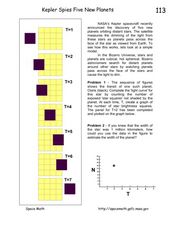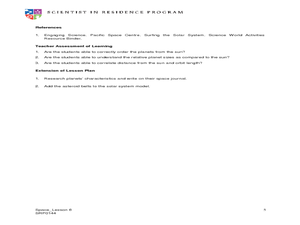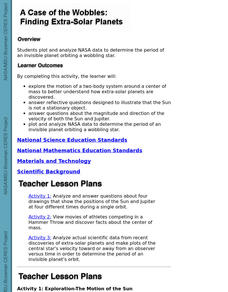Curated OER
How To Build a Planet From The Inside Out!
High schoolers read about the Spitzer Space Telescope and the technology used to learn about planet composition. They calculate the radius of a planet, the size of a planet, the average density of a planet and the likely core composition...
DK Publishing
Stars and Planets Connect the Dots
Reach for the stars with this cute connect-the-dots activity! Kindergartners practice their counting and number sequencing by connecting the numbers 1 through 6 or 10 in four different shapes. A rocketship is completed for them as an...
Curated OER
Kepler Spies Five New Planets
In this discovering new planets worksheet, students read about how the Kepler spacecraft detects new planets by observing the dimming of light emitted by stars as the planets pass in front of them. Students solve 2 problems using a...
Curated OER
Space: Our Star, the Sun, and Its Friends, the Planets
Young scholars examine the solar system. In this space lesson, students identify the order of the planets and their relative size to the sun. Young scholars create a scale model of our solar system using a variety of household objects.
Curated OER
Organic Molecules Detected on Distant Planet!
Here is a planet instructional activity in which learners read about organic molecules detected through spectral lines of the planet Osiris. They calculate the mass, the volume and the densities of common ingredients for planets...
Curated OER
Star Circles
In this star circles worksheet, students solve six problems given a diagram of a time-exposure photograph of the stars. Students determine the scale of the image, the location of the North Celestial Pole, they identify Polaris and they...
Curated OER
Kepler-The Hunt for Earth-like Planets
In this hunt for planets activity, students read about the Kepler satellite used to detect exoplanets. Students solve 6 problems including drawing a sun disk and determining the scale in kilometers/millimeter, finding the area of the Sun...
Curated OER
Scale Activities
How do you put something as large as the universe in perspective? Use a series of scale experiments. Classmates collaborate around four experiments to examine the scale of the earth-moon system, our solar system, the Milky Way galaxy,...
Curated OER
Unit 2 Sun & Stars
Students describe stellar objects using terms such as stars, planets, satellites, orbits and light. In this sun and stars unit, students research stellar objects through seven individual lessons discovering star characteristics, how...
Curated OER
Finding Extra-Solar Planets
High schoolers plot and analyze NASA data to determine the period of an invisible planet orbiting a wobbling star. They explore the motion of a two-body system around a center of mass to better explain how extra-solar planets are...
Curated OER
Planetary Conjunctions
In this planetary conjunctions worksheet, learners read about planetary alignments and they solve 2 problems. They determine the location of 3 planets given their orbit time after 1, 2 , 3 and 4 years and they determine when three given...
Curated OER
And a Star to Steer Her By: A Field Trip Guide for the Planetarium Show
In this field trip study guide for the planetarium show lesson, students construct a model of the Earth and describe the relative positions of the continents using latitude and longitude. Students construct a star chart to find...
Curated OER
From Dust Grains to Dust Balls
In this formation of planets worksheet, students solve 6 problems including finding the equation for the mass of rocks as a function of time, finding the equation for the rate of growth of the mass of rocks and integrating these equations.
Curated OER
Stars Planets Space Workheet
In this visual discrimination worksheet, students examine 8 space-related pictures and determine the number of different types of shapes pictured.
Curated OER
The Drake Equation
Students use the Drake Equation to calculate the probability of sustaining life on various planets. Through the use of the equation, they determine whether intelligent and advanced civilizations can be developed on planets other than...
Curated OER
Why do Stars Rise in the East?
In this stars rise in the east instructional activity, students use geometry to show how the Earth rotates from west to east and why celestial bodies appear to rise in the east and set in the west. Students draw a figure and label given...
Curated OER
Meet the Neighbors: Planets Around Nearby Stars
Students explain why a transiting planet causes a periodic dimming in the light from its parent star. They determine the radius of a planet, and its orbital distance, by analyzing data and manipulating equations. Students compare the...
Curated OER
The North (Wall) Star
Young scholars engage in a lesson which shows them that celestial navigation is the art and science of finding one's geographic position by means of astronomical observations, particularly by measuring altitudes of celestial objects -...
EngageNY
The Motion of the Moon, Sun, and Stars—Motivating Mathematics
What does math have to do with the behavior of the earth and sun? Learn how the movement of celestial bodies has influenced the development of trigonometry. Scholars connects the details in mathematics to their...
Curated OER
Interstellar Real Estate - Defining The Habitable Zone
Students explore the orbital characteristics a planetary home needs to support Earth-like life forms. They develop an understanding of critical planetary mass to determine which newly discovered planets might be capable of supporting life.
Curated OER
Finding Mass in the Cosmos
In this finding mass in the cosmos instructional activity, students use the equations for the force of gravity, the centrifugal force pushing a planet outwards and the speed of a planet to solve 2 problems. They find the mass of primary...
Curated OER
Star Wars Activity
Students investigate radiant energy by completing discrepant events and identify various temperature changes through absorption and how radiant energy can be used for solar panels. They experiment with different color fabrics in order...
NASA
Exploring Exoplanets with Kepler
Calculate the movement and properties of planets like professional astronomers! Scholars use Kepler's third law to find Mercury and Venus's distance from the sun. Using changes in brightness of distant stars and Kepler's third law,...
Curated OER
Working With Scientific Notation
In this scientific notation worksheet, learners read about the discovery of new planets. They use scientific notation to identify the number of miles from one planet to the next. Students determine how long it would take to travel, when...
Other popular searches
- Space, Stars and Planets
- The Stars and Planets
- Stars and Planets Worksheets
- Compare Stars and Planets
- Stars and Planets Puzzles
- Space Stars and Planets
- Space\, Stars and Planets
- Planets and Stars
- Comparing Planets and Stars
- Space\\, Stars and Planets
- Planets Stars























